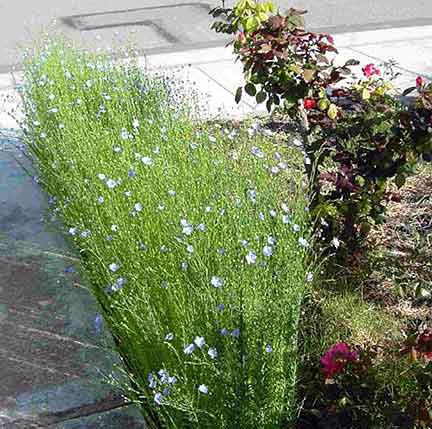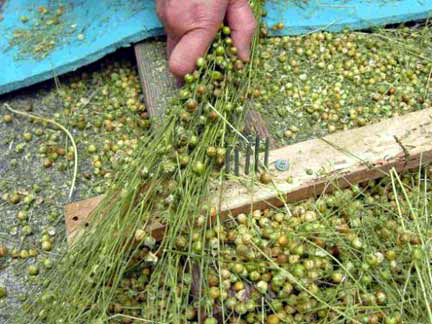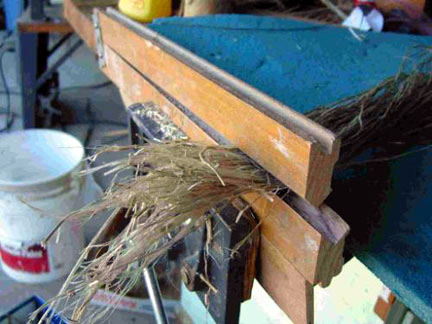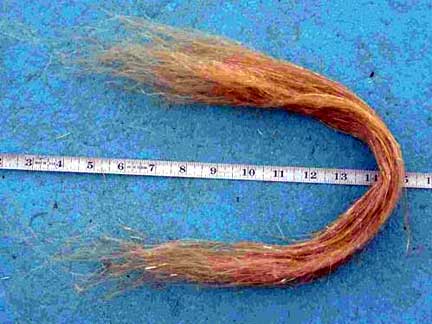
It's easy to grow your own flax for bowstrings, sewing or anything
else. Properly processed flax fibers are very strong and have
little stretch, the two most important characteristics for bowstrings.
There are different horticultural varieties of flax, one optimized
for seed production and another optimized for fiber production.
I don't know how different the two are. The variety that is easiest
to obtain is the seed variety. Go to your friendly neighborhood
health food store and buy some flax seeds. It's that simple.
Planting
Prepare the ground and put in the seeds. How many seeds per square
foot of ground? I give you the same answer "She who must
be obeyed" gives when asked how long does she bake her bread,
"Enough". Plant seeds very close together to encourage
tall growth and few branches. Cover with about 1 inch (2.5 cm.)
of soil. I mentioned what I was doing to Alice Tulloch, a fiber,
spinning, knitting, fabric maven. Her advice on flax culture was
"Think Ireland". The smeraldic countryside of Ireland
is a result of plentiful rain and sun. I put the seeds in the
ground in early March and watered them almost every day. In early
May most of the stalks in the full-sun patch were about 30 inches
(76 cm) tall and producing ephemeral pretty blue blossoms.

Harvesting
The flax was pulled from the ground on June 5, 2004,
after it no longer put out very many flowers. Many of the stalks
were over 36 inches long. Pull, don't cut because you want the
stalks as long as possible. Let the stalks dry completely before
the next step.
Rippling
Remove the seed pods by pulling the stalks through
a coarse metal toothed comb.

Retting
Use bacterial decomposition to help separate the desired
bast fibers from the woody stems. The amount of time required
to accomplish the retting is highly variable, depending on the
temperature and quality of the water used. It may take from five
to fourteen days The general rule is that it won't be ready until
the stuff starts to smell a little bit. I retted the flax in a
plastic garbage can. After filling the can half full of tap water,
I threw in a shovelful of dirt. The reason for the dirt is that
our city water contains chloramine as a disinfectant. The dirt
should overwhelm the disinfectant so that bacterial action will
start.
Testing
When you think the retting is complete, pull out a
couple of stalks and let them dry. The bast fiber should separate
easily from the stem. If not, then continue the retting. After
the retting is completed the stalks must be rinsed and dried.
Dressing
The general process of separating the fibers from the
stems and preparing them for spinning. It consists of:
Breaking
Flatten the stalks with a beetle (wooden mallet). Don't hit
them so hard that you cut the fibers. Next pass them through a
gizmo like Figure 3 to break up the stems into small pieces.

Scutching
Pass the broken stalks through a metal toothed comb to remove
the woody stem fragments. I made mine from finishing nails in
a piece of hardwood. You should obtain a skein of long fibers
with practically none of the stem adhering. Tow, the short fibers
that remain in the comb, are less desirable. I bought some beautiful
commercial flax with fibers from XX to YY long. Beautiful stuff.
My home grown stuff has somewhat shorter fibers. For the best
results, scutching was done with coarse, medium and fine scutchers.


From Fiber to Bowstring
The next step is to spin the fibers into small diameter cord.
The cord should be small enough in diameter that at least four
plies are needed to make up the finished bowstring. One ounce
(438 grains = 28.4 grams) of fibers should be plenty to make a
heavy duty bowstring. The best description of how to make a bowstring
from unspun flax fibers to single ply cord to finished bowstring
is in Tim Baker's chapter on bowstrings in Volume 2 of the Traditional
Bowyer's Bible. He states that a string for a fifty pound
bow made by a novice would weigh about 300 grains. A string for
the same bow made from good material by an expert would weigh
about 100 grains. Other descriptions on how to make single-ply
cord with a drop spindle can be found on the web. The main objective
of this article is to inspire you to grow and process your own
flax fiber. Once you have the fiber you are on your own. There
are plenty of information sources out there on how to spin fibers
into cord and make bowstrings. Get busy!
E-mail your comments to "Richard A. Baugh" at richardbaugh@att.net
We hope the information on the PrimitiveWays website is both instructional and enjoyable. Understand that no warranty or guarantee is included. We expect adults to act responsibly and children to be supervised by a responsible adult. If you use the information on this site to create your own projects or if you try techniques described on PrimitiveWays, behave in accordance with applicable laws, and think about the sustainability of natural resources. Using tools or techniques described on PrimitiveWays can be dangerous with exposure to heavy, sharp or pointed objects, fire, stone tools and hazards present in outdoor settings. Without proper care and caution, or if done incorrectly, there is a risk of property damage, personal injury or even death. So, be advised: Anyone using any information provided on the PrimitiveWays website assumes responsibility for using proper care and caution to protect property, the life, health and safety of himself or herself and all others. He or she expressly assumes all risk of harm or damage to all persons or property proximately caused by the use of this information.
© PrimitiveWays 2013